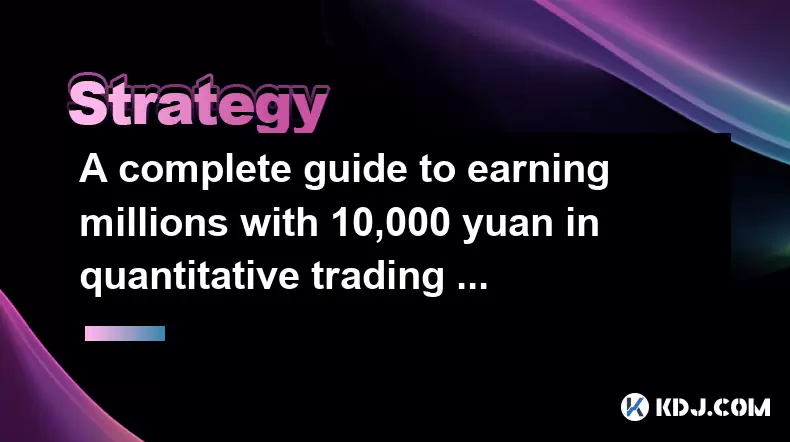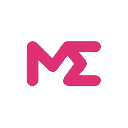-
 bitcoin
bitcoin $114779.865156 USD
2.30% -
 ethereum
ethereum $4226.519789 USD
2.39% -
 tether
tether $1.000545 USD
0.04% -
 xrp
xrp $2.890223 USD
0.92% -
 bnb
bnb $1030.029301 USD
2.95% -
 solana
solana $212.824944 USD
1.69% -
 usd-coin
usd-coin $0.999757 USD
0.01% -
 dogecoin
dogecoin $0.234961 USD
-0.27% -
 tron
tron $0.337174 USD
0.42% -
 cardano
cardano $0.804783 USD
0.09% -
 hyperliquid
hyperliquid $45.748770 USD
-2.85% -
 chainlink
chainlink $21.699170 USD
0.82% -
 ethena-usde
ethena-usde $1.001452 USD
0.08% -
 avalanche
avalanche $30.237800 USD
1.14% -
 stellar
stellar $0.372604 USD
1.52%
A complete guide to earning millions with 10,000 yuan in quantitative trading in the cryptocurrency circle
Quantitative trading in crypto can turn 10,000 yuan into millions with the right strategies, from setting up a trading environment to algorithm development and execution.
Jun 12, 2025 at 08:49 pm

Quantitative trading in the cryptocurrency market can be a lucrative venture, even when starting with a modest amount like 10,000 yuan. This guide will walk you through the essential steps and strategies to maximize your potential earnings through quantitative trading. From setting up your trading environment to developing and executing your trading algorithms, this comprehensive guide will help you navigate the complex world of cryptocurrency trading.
Understanding Quantitative Trading
Quantitative trading involves using mathematical models and algorithms to make trading decisions. In the cryptocurrency market, this means developing strategies to buy and sell cryptocurrencies based on data analysis and statistical methods. The goal is to leverage these algorithms to identify profitable trading opportunities that might be too complex or too fast for human traders to capitalize on.
To succeed in quantitative trading, you need a solid understanding of both the technical aspects of trading and the underlying principles of the cryptocurrency market. This includes knowledge of programming, data analysis, and risk management, as well as an understanding of market trends and cryptocurrency fundamentals.
Setting Up Your Trading Environment
Before you can start trading, you need to set up a suitable trading environment. Here are the key steps to get started:
- Choose a Trading Platform: Select a reliable cryptocurrency exchange that offers an API for automated trading. Popular choices include Binance, Coinbase Pro, and Kraken.
- Set Up a Trading Account: Register and verify your account on the chosen platform. Ensure that you comply with all necessary KYC (Know Your Customer) and AML (Anti-Money Laundering) regulations.
- Configure Your API: Obtain your API keys from the exchange. These keys will allow your trading algorithms to interact with the exchange's trading systems.
- Select a Programming Language: Choose a programming language suitable for quantitative trading, such as Python or R. Python is particularly popular due to its extensive libraries for data analysis and machine learning.
- Install Necessary Tools: Install trading software such as MetaTrader, TradingView, or custom-built solutions. Ensure you have the necessary libraries and frameworks, like Pandas, NumPy, and Scikit-learn for Python.
Developing Your Trading Algorithm
Creating an effective trading algorithm is the heart of quantitative trading. Here’s how you can develop one:
- Define Your Strategy: Start by defining your trading strategy. This could be based on technical indicators, statistical arbitrage, or machine learning models. For example, you might use moving averages to identify trends or develop a model that predicts price movements based on historical data.
- Backtest Your Strategy: Use historical data to test your algorithm. Backtesting helps you understand how your strategy would have performed in the past, allowing you to refine it before going live. Tools like Backtrader or Zipline can be used for backtesting in Python.
- Optimize Your Algorithm: Fine-tune your algorithm by adjusting parameters and testing different scenarios. This might involve using optimization techniques like grid search or genetic algorithms to find the best settings for your strategy.
- Implement Risk Management: Incorporate risk management rules into your algorithm to protect your capital. This could include setting stop-loss orders, position sizing, and diversifying your trades.
Executing Your Trades
Once your algorithm is ready, you can start executing trades. Here’s how to do it effectively:
- Connect to the Exchange: Use your API keys to connect your trading algorithm to the exchange. Ensure that your connection is secure and that you have proper error handling in place.
- Monitor Your Trades: Keep a close eye on your trades as they execute. Use real-time data to adjust your strategy if necessary. Tools like dashboards and alerts can help you stay informed.
- Review and Adjust: Regularly review the performance of your algorithm and make adjustments as needed. This might involve updating your strategy based on new market conditions or improving your algorithm based on new data.
Managing Your Capital
Effective capital management is crucial for long-term success in quantitative trading. Here are some tips to manage your 10,000 yuan effectively:
- Start Small: Begin with a small portion of your capital to test your strategy in real market conditions. This minimizes risk while you gain experience.
- Diversify Your Portfolio: Spread your investments across different cryptocurrencies and trading strategies. Diversification can help mitigate risk and increase your chances of earning profits.
- Reinvest Profits: Use your profits to increase your trading capital. Reinvesting can help you grow your account over time, but be sure to balance this with risk management.
- Set Realistic Goals: Set achievable goals for your trading. Understand that earning millions with 10,000 yuan will take time and consistent effort.
Analyzing and Improving Your Strategy
Continuous improvement is key to success in quantitative trading. Here’s how you can analyze and enhance your strategy:
- Track Performance Metrics: Keep track of key performance indicators such as return on investment (ROI), Sharpe ratio, and drawdowns. These metrics can help you evaluate the effectiveness of your strategy.
- Analyze Market Conditions: Stay informed about market trends and news that could impact your trading strategy. Adjust your algorithm to account for changes in market conditions.
- Learn from Mistakes: Use losses as learning opportunities. Analyze what went wrong and how you can improve your strategy to avoid similar mistakes in the future.
- Stay Updated with Technology: The field of quantitative trading is constantly evolving. Stay updated with the latest tools, techniques, and technologies to keep your strategy competitive.
Frequently Asked Questions
Q: How long does it typically take to see significant returns from quantitative trading with 10,000 yuan?A: The time it takes to see significant returns can vary widely based on your strategy, market conditions, and the effectiveness of your algorithm. Some traders may see returns within a few months, while others might take years to achieve their goals. Consistency and continuous improvement are key factors in achieving long-term success.
Q: Can I use leverage to increase my potential earnings in quantitative trading?A: Yes, leverage can be used to increase potential returns, but it also increases risk. It’s important to use leverage cautiously and ensure that your trading algorithm can handle the increased volatility and potential for larger losses.
Q: What are the most common pitfalls to avoid in quantitative trading?A: Common pitfalls include over-optimizing your algorithm based on historical data, neglecting risk management, and not adapting to changing market conditions. It’s also important to avoid emotional trading and to stick to your strategy even during periods of loss.
Q: Is it necessary to have a background in programming or finance to succeed in quantitative trading?A: While a background in programming or finance can be beneficial, it’s not strictly necessary. Many successful quantitative traders have learned these skills through self-study and practice. What’s more important is a willingness to learn, a disciplined approach to trading, and the ability to develop and refine your strategies over time.
Disclaimer:info@kdj.com
The information provided is not trading advice. kdj.com does not assume any responsibility for any investments made based on the information provided in this article. Cryptocurrencies are highly volatile and it is highly recommended that you invest with caution after thorough research!
If you believe that the content used on this website infringes your copyright, please contact us immediately (info@kdj.com) and we will delete it promptly.
- Bitcoin, Ethereum, and Correction Concerns: Navigating the Crypto Seas
- 2025-09-30 08:25:12
- ATH Crypto's $344M DePIN Treasury: Aethir's Bold Plan and Market Impact
- 2025-09-30 08:45:14
- XRP, Institutions, and ETF Filings: A New Era for Crypto?
- 2025-09-30 08:45:14
- Crypto Presales: Unveiling Growth Opportunities and the Quest for 100x Returns
- 2025-09-30 08:50:01
- China's Yuan Stablecoin: A Play to Challenge the Dollar's Digital Dominance?
- 2025-09-30 08:50:01
- Crypto Coins with 100x Potential: Navigating the Presale Opportunity Landscape
- 2025-09-30 08:50:01
Related knowledge

Practical parameter settings for a Bitcoin multi-timeframe moving average system
Sep 18,2025 at 10:54pm
Optimizing Timeframe Combinations for Bitcoin Trading1. Selecting appropriate timeframes is crucial when building a multi-timeframe moving average sys...

How can I filter out false breakouts in Dogecoin high-frequency trading?
Sep 22,2025 at 01:00am
Understanding False Breakouts in Dogecoin Trading1. A false breakout occurs when Dogecoin's price appears to move beyond a defined support or resistan...

Techniques for identifying tops and bottoms in the Bitcoin on-chain NVT model
Sep 20,2025 at 07:54pm
Understanding the NVT Model in Bitcoin Analysis1. The Network Value to Transactions (NVT) ratio is often described as the 'P/E ratio' of the cryptocur...

What does the surge in open interest in Bitcoincoin futures mean?
Sep 20,2025 at 11:18pm
Understanding the Surge in Dogecoin Futures Open Interest1. A surge in open interest within Dogecoin futures indicates a growing number of active cont...

How can I use the Ethereum USDT premium to gauge market sentiment?
Sep 18,2025 at 11:55pm
Understanding the Ethereum USDT Premium1. The Ethereum USDT premium refers to the price difference between USDT (Tether) traded on Ethereum-based plat...

What should I do if Ethereum staking yields decline?
Sep 20,2025 at 06:18am
Understanding the Causes Behind Declining Ethereum Staking Yields1. The Ethereum network transitioned to a proof-of-stake consensus mechanism with the...

Practical parameter settings for a Bitcoin multi-timeframe moving average system
Sep 18,2025 at 10:54pm
Optimizing Timeframe Combinations for Bitcoin Trading1. Selecting appropriate timeframes is crucial when building a multi-timeframe moving average sys...

How can I filter out false breakouts in Dogecoin high-frequency trading?
Sep 22,2025 at 01:00am
Understanding False Breakouts in Dogecoin Trading1. A false breakout occurs when Dogecoin's price appears to move beyond a defined support or resistan...

Techniques for identifying tops and bottoms in the Bitcoin on-chain NVT model
Sep 20,2025 at 07:54pm
Understanding the NVT Model in Bitcoin Analysis1. The Network Value to Transactions (NVT) ratio is often described as the 'P/E ratio' of the cryptocur...

What does the surge in open interest in Bitcoincoin futures mean?
Sep 20,2025 at 11:18pm
Understanding the Surge in Dogecoin Futures Open Interest1. A surge in open interest within Dogecoin futures indicates a growing number of active cont...

How can I use the Ethereum USDT premium to gauge market sentiment?
Sep 18,2025 at 11:55pm
Understanding the Ethereum USDT Premium1. The Ethereum USDT premium refers to the price difference between USDT (Tether) traded on Ethereum-based plat...

What should I do if Ethereum staking yields decline?
Sep 20,2025 at 06:18am
Understanding the Causes Behind Declining Ethereum Staking Yields1. The Ethereum network transitioned to a proof-of-stake consensus mechanism with the...
See all articles










































































